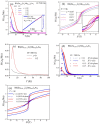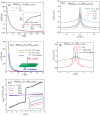Colossal Magnetoresistance in Layered Diluted Magnetic Semiconductor Rb(Zn,Li,Mn)4As3 Single Crystals
- PMID: 38334534
- PMCID: PMC10856780
- DOI: 10.3390/nano14030263
Colossal Magnetoresistance in Layered Diluted Magnetic Semiconductor Rb(Zn,Li,Mn)4As3 Single Crystals
Abstract
Diluted magnetic semiconductors (DMSs) with tunable ferromagnetism are among the most promising materials for fabricating spintronic devices. Some DMS systems have sizeable magnetoresistances that can further extend their applications. Here, we report a new DMS Rb(Zn1-x-yLiyMnx)4As3 with a quasi-two-dimensional structure showing sizeable anisotropies in its ferromagnetism and transverse magnetoresistance (MR). With proper charge and spin doping, single crystals of the DMS display Curie temperatures up to 24 K. Analysis of the critical behavior via Arrott plots confirms the long-range ferromagnetic ordering in the Rb(Zn1-x-yLiyMnx)4As3 single crystals. We observed remarkable intrinsic MR effects in the single crystals (i.e., a positive MR of 85% at 0.4 T and a colossal negative MR of -93% at 7 T).
Keywords: colossal magnetoresistance; diluted magnetic semiconductor; quasi-two-dimensional structure; single crystal.
Conflict of interest statement
The authors declare no conflicts of interest.
Figures




Similar articles
-
Colossal Magnetoresistance in Ti Lightly Doped Cr2Se3 Single Crystals with a Layered Structure.ACS Appl Mater Interfaces. 2021 Dec 15;13(49):58949-58955. doi: 10.1021/acsami.1c18848. Epub 2021 Dec 2. ACS Appl Mater Interfaces. 2021. PMID: 34854300
-
New Fluoride-arsenide Diluted Magnetic Semiconductor (Ba,K)F(Zn,Mn)As with Independent Spin and Charge Doping.Sci Rep. 2016 Nov 22;6:36578. doi: 10.1038/srep36578. Sci Rep. 2016. PMID: 27874044 Free PMC article.
-
Li(Cd,Mn)P: a new cadmium based diluted ferromagnetic semiconductor with independent spin & charge doping.Sci Rep. 2019 May 16;9(1):7490. doi: 10.1038/s41598-019-43754-x. Sci Rep. 2019. PMID: 31097727 Free PMC article.
-
Engineering of Advanced Materials for High Magnetic Field Sensing: A Review.Sensors (Basel). 2023 Mar 8;23(6):2939. doi: 10.3390/s23062939. Sensors (Basel). 2023. PMID: 36991646 Free PMC article. Review.
-
Methods of Modeling of Strongly Correlated Electron Systems.Nanomaterials (Basel). 2023 Jan 5;13(2):238. doi: 10.3390/nano13020238. Nanomaterials (Basel). 2023. PMID: 36677990 Free PMC article. Review.
Cited by
-
Advanced Spintronic and Electronic Nanomaterials.Nanomaterials (Basel). 2024 Jul 2;14(13):1139. doi: 10.3390/nano14131139. Nanomaterials (Basel). 2024. PMID: 38998744 Free PMC article.
References
-
- Furdyna J.K. Diluted magnetic semiconductors. J. Appl. Phys. 1988;64:R29. doi: 10.1063/1.341700. - DOI
-
- Hirohata A., Sukegawa H., Yanagihara H., Zutic I., Seki T., Mizukami S., Swaminathan R. Roadmap for Emerging Materials for Spintronic Device Applications. IEEE Trans. Magn. 2015;51:0800511. doi: 10.1109/TMAG.2015.2457393. - DOI
-
- Dietl T., Ohno H. Dilute ferromagnetic semiconductors: Physics and spintronic structures. Rev. Mod. Phys. 2014;86:187–251. doi: 10.1103/RevModPhys.86.187. - DOI
-
- Zhao X., Dong J., Fu L., Gu Y., Zhang R., Yang Q., Xie L., Tang Y., Ning F. (Ba1−xNax)F(Zn1−xMnx)Sb: A novel fluoride-antimonide magnetic semiconductor with decoupled charge and spin doping. J. Semicond. 2022;43:112501. doi: 10.1088/1674-4926/43/11/112501. - DOI
Grants and funding
LinkOut - more resources
Full Text Sources
Research Materials

